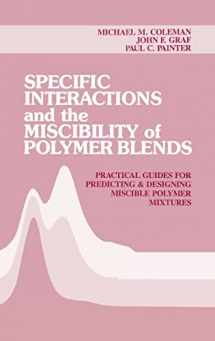
Specific Interactions and the Miscibility of Polymer Blends: Practical Guides For Predicting & Designing Miscible Polymer Mixtures
Book details
Summary
Description
This book with software provides powerful tools for the analysis, prediction and creation of new polymer blends, an area of significant commercial potential. The R&D approaches and methods described in the book have attracted the interest of polymer R&D leaders in industry, and have been put into use in several major chemical companies. The companion set of computer programs speeds and facilitates work in this area.
FROM THE AUTHORS' PREFACE:
During the 1980's a steadily increasing number of compatible systems [polymer blends] have been reported. We believe that miscible mixtures will prove to be fairly common and the purpose of this book is to explore the circumstances in which single phase materials can be obtained. We will also describe a model for the phase behavior of these mixtures which we believe to have a predictive value, or be used as a practical guide to polymer miscibility.
Our approach is based on the use of association models which have until recently been largely ignored in treating hydrogen bonding in polymer mixtures. They have most frequently been applied to mixtures of alcohols with simple hydrocarbons, where the equilibrium constants used to describe association have most frequently been determined by a fit to thermodynamic data (e.g., vapor pressures, heat of mixing). In our work we have sought to, first, adapt this approach to a description of the phase behavior of polymer mixtures; second, develop spectroscopic methods that provide an independent measurement of the equilibrium constants.
Our purpose in this book is to explore and describe this approach and illustrate its broad utility. We address two overlapping yet different audiences. One would be primarily interested in the broad nature of this approach and the practical applications of a simple model. The second would be more interested in the derivations of the equations and some of the fundamental aspects of the spectroscopy of these systems.
Accordingly this book is in the form of a sandwich. We begin with a brief introduction to theories of mixing and the phase behavior of polymeric mixtures, followed by a practical guide to polymer miscibility. This chapter also serves to identify the types of systems in which, by copolymerization or other means, one might introduce the appropriate hydrogen bonding functional groups and obtain a miscible system.
The [main substance] of this book is in [the] chapters where fundamental aspects of hydrogen bonds, spectroscopy and the application of association models are described. We also offer [separately] computer programs that calculate and display many of the important quantities described in this book (e.g., the stoichiometry of hydrogen bonding and its relationship to infrared measurements, phase behavior, etc.). In our view one can obtain a good feel for the miscibility of many systems with these programs.


We would LOVE it if you could help us and other readers by reviewing the book
Book review



